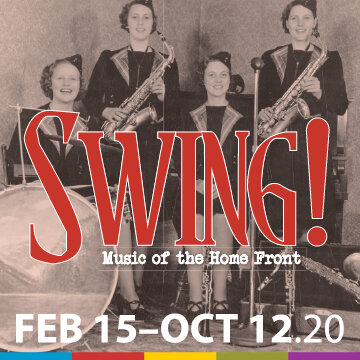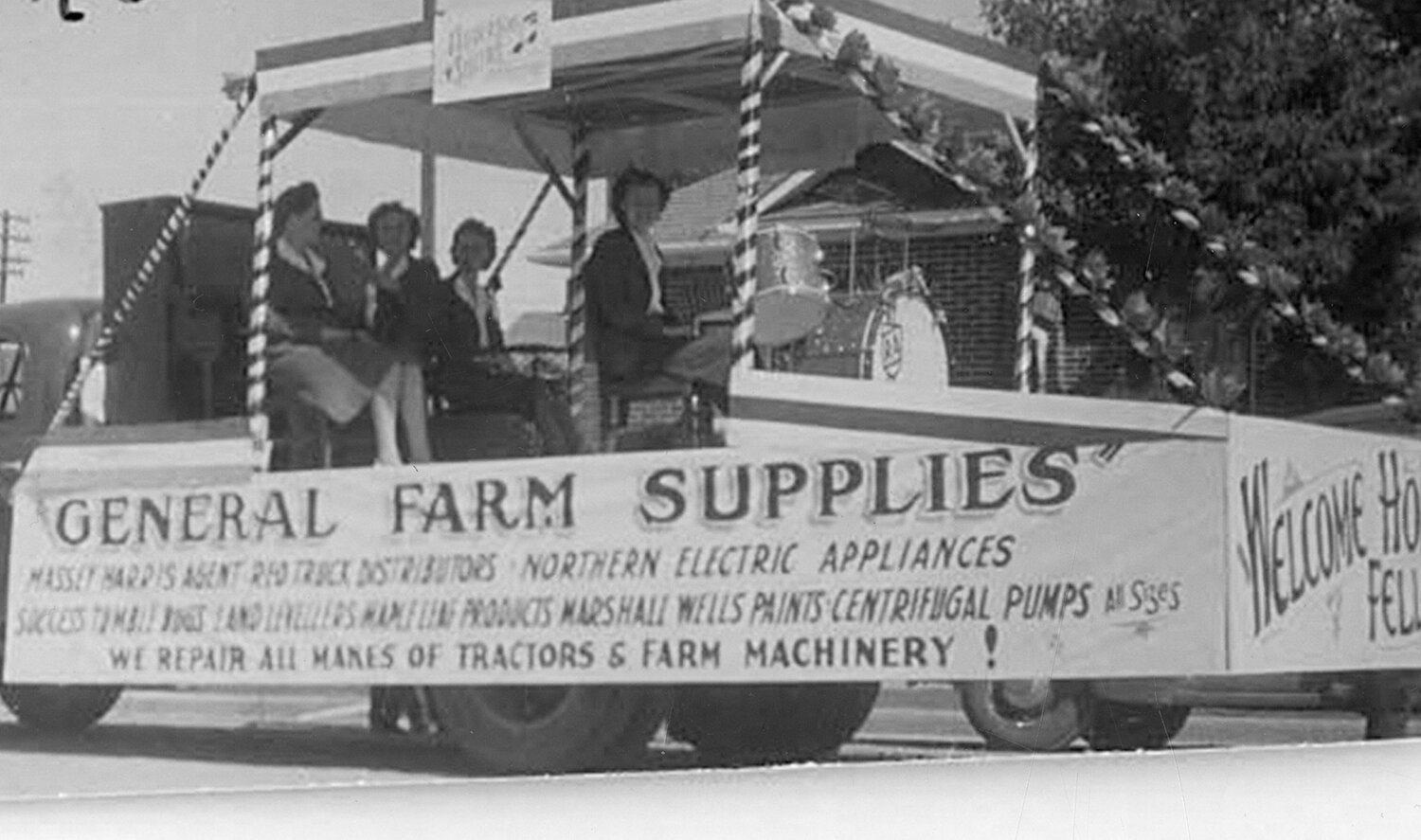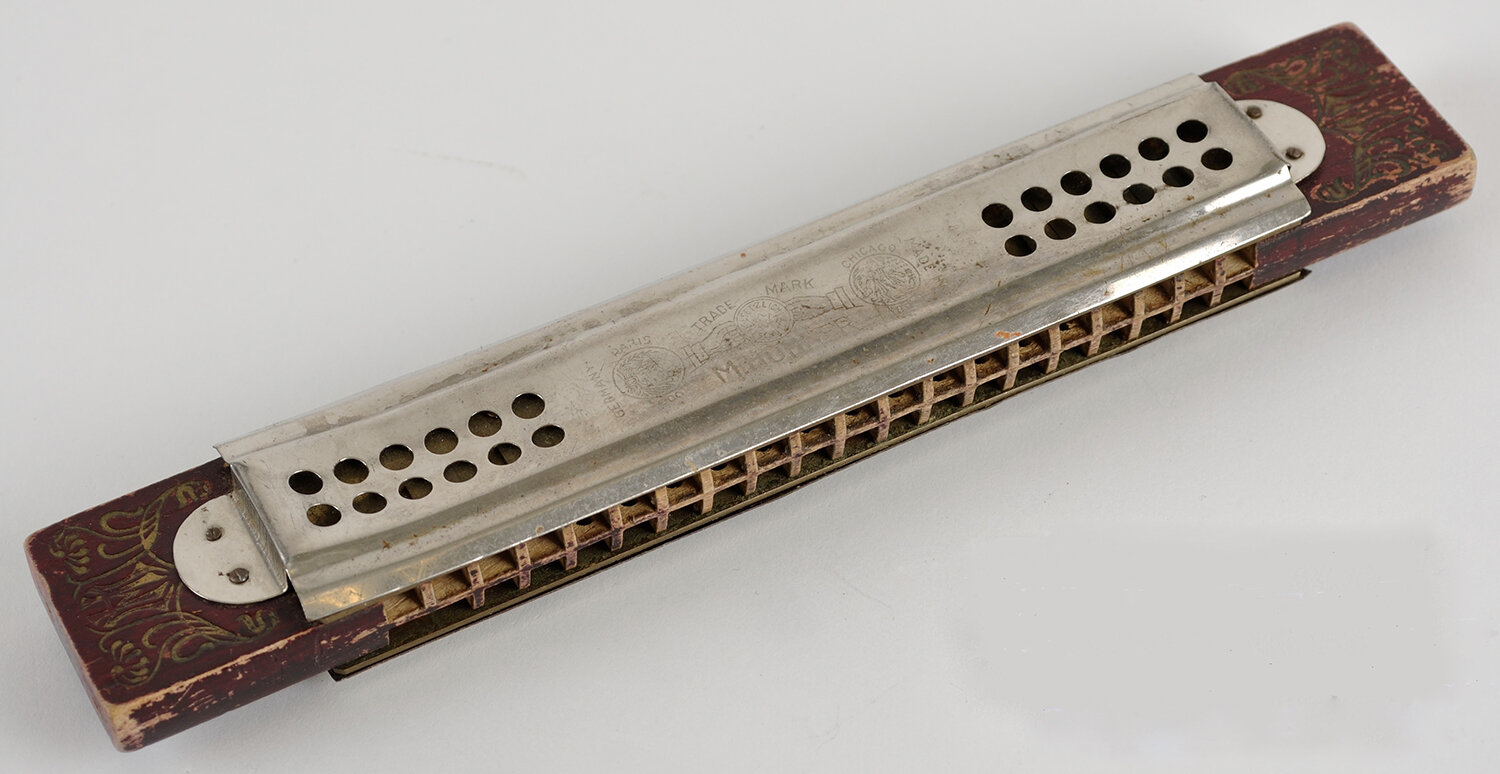Swing! Logo
curated by Grace Wilson and Aimee Benoit
Between 1939 and 1945 Lethbridge was absorbed into the “home front” culture of the Second World War. The city transformed with the construction of an extensive prisoner of war camp and an influx of air training personnel from around the Commonwealth. Residents said goodbye to loved ones in the services, and were called on to make sacrifices through food rationing and other wartime controls.
Despite these disruptions, however, there were bright spots that helped maintain positive morale. Inspired by North American greats like Duke Ellington, Count Basie and Tommy Dorsey, local big band groups played an energetic, swinging style of music that brought crowds to dance halls and joy to the community.
“I have wonderful memories of those days, the good clean fun, and attending a dance once or twice a week… I have often thought that I was born at a good time; there couldn’t have been a more sociable time in history than what I experienced.”
Hazel Berke (Interview with Lisa Doolittle, 1999)
Alberta Ranch Boys playing for the Galt School of Nursing Valentine’s Dance, 1945.
Galt Museum & Archives, 19881045009.
“It was just straight foxtrot, waltz, jive. And man did they jive in those days.”
Len Isaacson (Interview with Lisa Doolittle, 2000)
The Anderson Sisters
Growing up in the village of Monitor, Alberta, sisters Florence, Marie, Alice and Ruth Anderson were immersed in music from a young age. The “four maids of melody” became skilled at multiple instruments; the youngest, Ruth, could play the drums and trumpet at the same time!
During the Depression of the 1930s, the Anderson family moved to Lethbridge, where the sisters’ musical careers took off. Within days of arriving, the Anderson Sisters began a regular program of live shows on CJOC radio. Their father Martin became their manager and promoter, lining up frequent performances at the Waterton Lakes Dance Pavilion, the Trianon Ballroom in Lethbridge, and military bases in the area.
Anderson Sisters in Victory Loan parade in Lethbridge, 1941.
Galt Museum & Archives, 20161112003007.
Humble and quiet by nature, the Anderson Sisters were passionate about their music and their stage presence. Every detail was meticulous, down to their matching uniforms and jewelry. Throughout the war they supported community events, promoted war savings bonds, and even taught others how to become musicians themselves.
“I think, when it came to music, it was just something very, very special, and a gift they passed on… it was something they felt really privileged to be able to contribute to their own communities.”
Ruth Hummel (Interview with Kevin MacLean, 2016)
Anderson Sisters Orchestra at the Waterton Lakes National Park Dance Pavilion, 1941.
The Anderson Sisters played in Waterton for five straight seasons, making them the longest running performers at that venue. The group’s drumhead, pictured here, features an image of Upper Waterton Lake.
Galt Museum & Archives, 20161112003001.
Anderson Sisters Orchestra during a homecoming parade, 1945.
Galt Museum & Archives, 20161112003008.
Clarinet, ca. 1950–1960. Donated by Eleanor Smith and Ruth Hummel.
Alice Hummel (nee Anderson) purchased this clarinet in the early 1950s. She played it during some of the Anderson Sisters’ later performances, but bought it mainly for her first son Bernie. Bernie’s daughter, Connie, also later played this clarinet.
Galt Museum & Archives, P20160044003.
Cap and brooch, ca. 1940–1950. Donated by Eleanor Smith and Ruth Hummel.
During performances, the Anderson Sisters dressed alike in military-style dresses and matching accessories. Their caps were personalized with their names embroidered on the side.
Galt Museums & Archives, P20160044001; 006.
Mechanical pencil, ca. 1941–1950. Donated by Eleanor Smith and Ruth Hummel.
Alice Hummel (nee Anderson) kept this pencil on her music stand to make notations during Anderson Sisters performances. As Alice’s daughter recalled, the pencil was “useful, but very pretty to be up where they were doing their music. They treated their space on stage very specially.”
Galt Museum & Archives, P20160044002.
Alberta Ranch Boys
In the summer of 1937 friends Lou Gonzy, Curly Gurlock, Buck Waslovich, Remo Baceda and Joe Horhozer got together to form a band. After only two days of practicing, the Alberta Ranch Boys played for the Lethbridge and District Exhibition Parade, launching their musical career.
The Alberta Ranch Boys quickly became a popular act, touring British Columbia with their “cowboy swing” style. They landed in Vancouver in 1939, where they entertained service members on air with CKWX Radio. The band played at Victory Loan rallies, and released songs such as “We Bought Them Before and We Will Buy Them Again” to help promote war savings stamps.
Alberta Ranch Boys in the Lethbridge Exhibition parade, 1946.
Galt Museum & Archives, 20161098014.
The Alberta Ranch Boys were known across Canada, appearing with superstars such as Roy Rogers and Gene Autry. Once the war ended they were invited to New York to record their music and perform on television; however, they chose to settle down to a quieter life in Lethbridge. As Lou Gonzy later recalled, “If we so wished, we could have gone big, but we’re kind of glad we didn’t.”
“[Joe Horhozer] was exceptionally gifted with the accordion; that’s what everybody said, that there isn’t anyone, at least around this country, that could compare with him.”
Everal Horhozer (Interview with Kevin MacLean, 2015)
Trianon Ballroom, ca. 1940–1950.
The Alberta Ranch Boys were one of southern Alberta’s most popular groups during the 1940s. After the war, Lou Gonzy leased the Trianon Ballroom as the band’s home base.
Galt Museum & Archives, 19752290001.
Clarence Sirovyak, Jack Blech, Remo Baceda, Louis Gonzy and Joe Horhozer, ca. 1980.
Galt Museum & Archives, 20021001006.
Stephen (Steve) Robert Smerek, leader of the Royal Albertans Orchestra, ca. 1940–1945.
Galt Museum & Archives, 20191012000.
The Royal Albertans Orchestra
The Royal Albertans Orchestra was fronted by Steve Smerek, lead saxophonist and clarinet player. Through the 1940s the Royal Albertans were regulars at the Henderson Pavilion, also appearing at other dance halls in Lethbridge and Waterton.
The Royal Albertans were typical of many dance bands, with a changing roster of musicians as members joined the military or simply moved on. Pianist Jack Patey, for example, had started out in the orchestra pit for silent movies; he fronted several of his own bands and played for other local groups including Jack Heath and the Trianon Ballroom Orchestra.
Family lore has it that when Tommy Dorsey came through Lethbridge in 1951 he invited Steve Smerek to join him on the road—but Smerek turned down the offer in order to remain with his family. When the Royal Albertans dissolved that year, other members including Jack Patey and Nick Kucheran continued to play with dance bands well into the post-war years, though the heyday of the big bands had passed.
“Frankly, Jack [Patey] was the best piano player I ever played with.”
Milt Iverson (Quoted in Lethbridge Herald, 1986)
The Royal Albertans Orchestra in the Trianon Ballroom, ca. 1940–1950.
Galt Museum and Archives, 19981034022.
Alto saxophone, ca. 1930–1940. Donated by Barbara Legge and Robert Smerek.
Royal Albertans’ band leader Steve Smerek first took up the saxophone as a child, following a doctor’s recommendation that he strengthen his lungs. He also played the clarinet.
Galt Museums & Archives, P20190003000.
Bass drum, ca. 1939–1945. Donated by Mrs. Priestly.
Douglas Priestly played this drum as a member of several dance bands in southern Alberta, including the Jack Patey Trianon Orchestra. Like many big band musicians, Priestly played several instruments including the banjo, guitar and drums.
Galt Museum & Archives, P19930047001.
Harmonica, ca. 1890–1900. Donated by Ab Chervinski.
This harmonica reportedly belonged to Jack Patey who played organ, trumpet and trombone in several southern Alberta dance bands over a period of 60 years. During the Second World War, Patey played piano for the Royal Albertans Orchestra.
Galt Museum & Archives, P19970107029.
Prisoner of War Camp 133, ca. 1942–1946.
The POW band accompanies an operatic production at Camp 133. The prisoners contributed by making their own sets and costumes.
Galt Museum & Archives, 20101101012.
Camp 133 Orchestra
One of the more visible signs of the Second World War in Lethbridge was Camp 133. Canada’s largest Prisoner of War camp, it was built to house up to 12,500 German military personnel captured in North Africa. Under the terms of the Geneva Convention, prisoners received the same rations as Canadian troops on the home front. To help pass the time, they also had access to a library, recreational equipment and musical instruments—some of which came with the prisoners from Germany, and some that were provided by the YMCA and International Red Cross.
Lethbridge Camp 133 band, ca. 1942–1946.
Galt Museum & Archives, P20181033043.
Camp 133 had two of the largest recreation halls in Alberta at the time, each seating 5,000 people. The music hall was regularly used by the camp’s 55-piece band and 45-piece string orchestra. Camp musicians also provided accompaniment for plays, variety programs and operatic productions.
Lethbridge Camp 133 band, ca. 1942–1946.
Galt Museum & Archives, P20181033042.
Lethbridge Camp 133 string orchestra, ca. 1942–1946.
Galt Museum & Archives, 20101101011.
Tuba, 1939. Donated by Robert Findlay.
Made in Germany, this instrument was brought to Camp 133 along with German prisoners captured in battle in North Africa.
Galt Museum & Archives, P20190012000.
Accordion, ca. 1940–1950. Donated by Edith Evans.
This is one of several accordions used in Camp 133. When prisoners were repatriated back to Germany following the war, many of the camp’s musical instruments were acquired by the Association of Canadian Travelers (ACT) for use by its junior band.
Galt Museum & Archives, P20030056000.
Dance Halls
Lethbridge had a lively social dance culture throughout the war, with three main dance halls hosting live bands several days per week.
The Trianon Ballroom, which operated from 1931 to 1961, was the most popular place to be. It was centrally located on the corner of 5 Street and 1 Avenue South. Even in the winter the Trianon promised an oasis, with cardboard palm trees and ceiling stars decorating its 3,500 square foot space.
Crowds dancing in the Trianon Ballroom in Lethbridge, ca. 1940–1950.
Galt Museum & Archives, 19752290002.
Buses also shuttled passengers from the public library to the Henderson Lake Pavilion, which operated from 1929 to 1969. On Tuesday and Saturday nights during the war, the pavilion hosted jitney dances—where patrons bought a separate ticket for each song—and its dance floor was said to be one of the finest in southern Alberta.
Henderson Lake Pavilion, ca. 1920–1930.
Galt Museum & Archives, 19881022017.
Both the Trianon and Henderson Lake Pavilion were popular among service personnel, which included Air Force trainees from all over the British Commonwealth. Meanwhile, guards from Camp 133 favoured the Rainbow Ballroom, located not far from the camp on 5 Avenue North.
“The crowds [at the Trianon] were always big. I remember one New Year’s Eve we sold 1,000 tickets, with people coming and going all night.”
Lou Gonzy (Quoted in Lethbridge Herald, 1997)
Mart Kenney and His Western Gentlemen in Regina, ca. 1934.
Mart Kenney was Canada’s “king of swing”—one of the most popular band leaders of the wartime era. His orchestra made its radio debut on CJOC (Lethbridge) in 1934, and played frequently in the city through to the 1980s. Kenney’s most famous song “The West, a Nest and You Dear” is believed to be inspired by happy times in Lethbridge.
Galt Museum & Archives, 19831060000.
Cyril Roach and His Ambassadors playing on Lethbridge radio station CJOC, December 1936.
Cyril Roach briefly led one of the city’s rising dance bands before moving to Vancouver in 1937.
Galt Museum & Archives, 199110004398.
Hi-Hatters Dance Orchestra led by Ernie Woods, ca. 1940–1950.
Galt Museum & Archives, 201510061140.
Secondary Sources:
Doolittle, Lisa. “The Trianon and on: Reading mass social dancing in the 1930s and 1940s in Alberta, Canada.” Dance Research Journal 33, no.2 (Winter 2001/2002): 11-28.
Fooks, Georgia Green. Prairie Prisoners: POWs in Lethbridge During Two World Conflicts. Lethbridge: Lethbridge Historical Society, 2002.
Johnston, Alex and Den Otter, Andy A. Lethbridge: A Centennial History. Lethbridge: The City of Lethbridge and The Whoop-Up Country Chapter, Historical Society of Alberta, 1985.
Kilford, Christopher. Lethbridge at War: The Military History of Lethbridge from 1900 to 1996. Lethbridge: Battery Books & Publishing, 1996.
Malnig, Julie (ed). Ballroom, Boogie, Shimmy Sham, Shake: A Social and Popular Dance Reader. Champaign, IL: University of Illinois Press, 2008.
Viel, Aimee. Lethbridge on the Homefront, 1939–1945. Lethbridge: Lethbridge Historical Society, 1998.
Primary Sources:
Lethbridge Herald, miscellaneous clippings
Galt Museum & Archives, miscellaneous archives fonds
Galt Museum & Archives collections interviews
Everal Horhozer (2015)
Ruth Hummel and Eleanor Smith (2016)
Barbara Legge and Rob Smerek (2019)
Robert Findlay (2019)






























The Alberta Ranch Boys quickly became a popular act, touring British Columbia with their “cowboy swing” style.